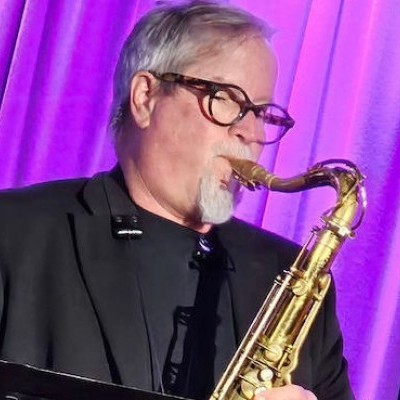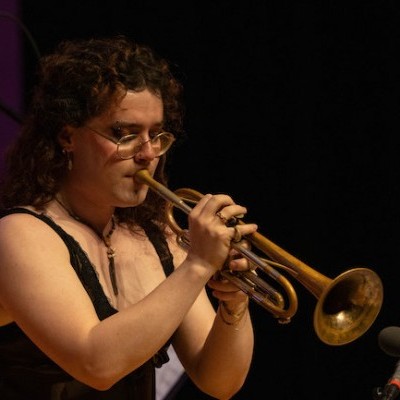Oct 28, 2025 10:47 AM
In Memoriam: Jack DeJohnette, 1942–2025
Jack DeJohnette, a bold and resourceful drummer and NEA Jazz Master who forged a unique vocabulary on the kit over his…

With the release of Nérija’s full-length debut, Blume (Domino), saxophonist Nubya Garcia’s career pushes on to a new stage.
(Photo: Emra Islek)Nubya Garcia exhibits spectacular leader instincts, but she thrives in collaborative settings.
Making her New York debut at (Le) Poisson Rogue during 2018’s Winter Jazzfest, the now 28-year-old tenor saxophonist was one of the event’s breakout stars. Fronting a mighty quartet populated by kindred spirits from her London stomping grounds, Garcia delivered languid, incantatory melodies that intensified incrementally until splintering into rapid-fire riffs and scalding cries.
She channeled the spiritual-jazz energy ignited by the likes of John Coltrane, Pharoah Sanders, Joe Henderson and Gary Bartz, and her phrasing was economical, almost prayer-like in its melodic pithiness. Still, there was a ferocious bite to her improvisations, especially when her rhythm section—drummer Femi Koleoso, bassist Daniel Casimir and keyboardist Joe Armon-Jones—spliced West Indian and Nigerian beats with dance idioms like grime and garage.
“I want to encapsulate dance-floor music’s energy,” Garcia told DownBeat the following day. “The stuff that I’ve been writing recently is focused on working more with electronics and imagining us playing in places that aren’t jazz clubs. I love jazz clubs. But I don’t want to only play in jazz clubs for the rest of my life.”
Those comments aren’t surprising, considering that Garcia has spent years in the orbit of Jazz re:freshed, which functions both as the name of a London label and an incubator for some of the U.K. talent that’s currently making waves at venues and jazz festivals around the globe. Through its Thursday night sessions at Mau Mau Bar in Notting Hill, as well as dates at South London’s STEEZ, Jazz re:freshed also is continuing to contribute to the proliferation of alternative spaces for young, black jazz musicians to hone their craft.
Armon-Jones—who has played with Garcia in multiple contexts, including his own ensemble—applauds her willingness to accept individuals’ voices and offer musicians ample space when she’s leading a band. “She really likes using the most people can offer in her gigs,” he said. “She doesn’t hire people in her band and then constrict what they are able to do just because she hears the music a certain way. She writes the music, then lets you express yourself over that. A lot of times in recording sessions, [bandleaders] will have a very specific way of how they want you to play something. She’s not like that. She’s open to what you want to bring on the date as well.”
Garcia’s (Le) Poisson Rouge performance came on the heels of her acclaimed debut EP, Nubya’s 5ive (Jazz re:freshed), and ahead of her 2018 EP, When We Are (Nyasha). Just prior to her New York gig, Nérija, another ensemble Garcia contributes to, had won the U.K.’s 2017 Parliamentary Jazz Award for “Newcomer of the Year.”
At the time, the saxophonist also was excited about the release of 2018’s We Out Here (Brownswood), a watershed compilation and documentary film that chronicled much of London’s underground jazz scene, and featured more than 30 other musicians, including reedist Shabaka Hutchings, drummer Moses Boyd and tuba player Theon Cross. The album featured Garcia’s snapping composition “Once,” which boogies to a skittering rhythm and alludes to West London’s broken-beat scene, while her piercing flute is showcased on the phantasmagorical “Inside The Acorn,” a tune by the London ensemble Maisha.
Now, with the release of Nérija’s dynamic full-length debut, Blume (Domino), Garcia’s career pushes on to a new stage. But it would be misleading to cite Garcia as Nérija’s bandleader. The septet is a collective of musicians with their own solo careers, each member contributing to the ensemble’s songbook.
The band’s name is the French spelling of the Hebrew word “Nerijah,” which translates to “lamb of God.” Nérija’s alto saxophonist, Cassie Kinoshi, named the band, but drummer Lizy Exell pointed out, “The band’s music doesn’t have any religious relevance.”
Still, the music on Blume conveys an undeniably warm spirituality that reflects Nérija’s glowing rapport and collaborative ethos. The septet’s eponymous, self-released 2016 EP, which Domino recently reissued, featured five tunes written by individual members of the band. On Blume, they co-composed two of the songs: the reggae-influenced “Nascence,” which features rousing solos from Exell, trombonist Rosie Turton and trumpeter Sheila Maurice-Grey; and the florid, Brazil-meets-West Africa gem “Riverfest,” which becomes a vehicle for Shirley Tetteh to showcase her distinctive guitar skills.
Collectively, the writing on Blume boasts an ebullient, opulent sound that recalls at once Art Blakey & The Jazz Messengers, Carla Bley and many of the Euro-Caribbean and Afropean rhythmic gaits now prevalent on London’s black jazz scene.

Jack DeJohnette boasted a musical resume that was as long as it was fearsome.
Oct 28, 2025 10:47 AM
Jack DeJohnette, a bold and resourceful drummer and NEA Jazz Master who forged a unique vocabulary on the kit over his…

“I’ve told students, ‘I don’t mind if you use AI for this or that project,’” says MIT’s Pascal Le Boeuf. “‘But you need to tell me.’”
Sep 18, 2025 11:14 AM
A standard joke when it comes to discussing artificial intelligence, or AI, is that it’s developing so rapidly that…

Chuck Manning Works for NASA … and plays jazz.
Sep 18, 2025 11:23 AM
Congratulations! After years of study, you’ve earned your degree in jazz performance. But let’s face it: Making a…

Always a sharp dresser, Farnsworth wears a pocket square given to him by trumpeter Art Farmer. “You need to look good if you want to hang around me,” Farmer told him.
Sep 23, 2025 11:12 AM
When he was 12 years old, the hard-swinging veteran drummer Joe Farnsworth had a fateful encounter with his idol Max…

“Make time and energy to meet people and make friends,” suggests Millie Ahearn, a student at DePaul University.
Sep 18, 2025 11:32 AM
For many students, the transition into a collegiate jazz program can feel overwhelming — new peers, unfamiliar…